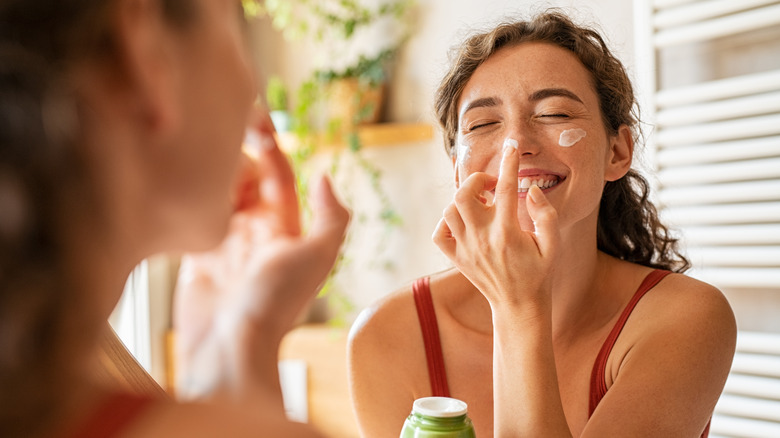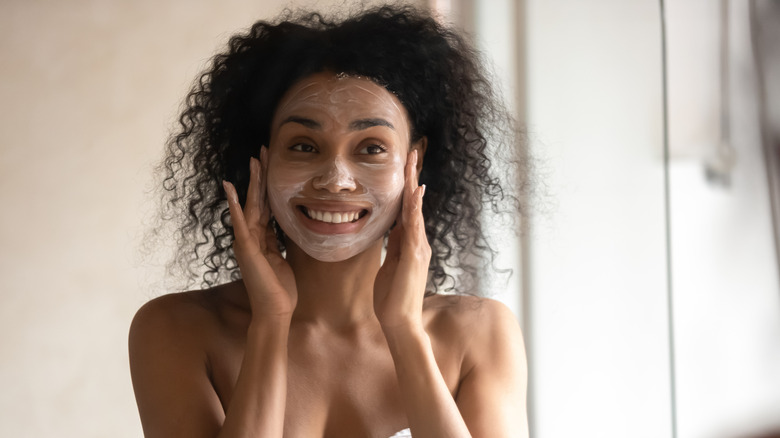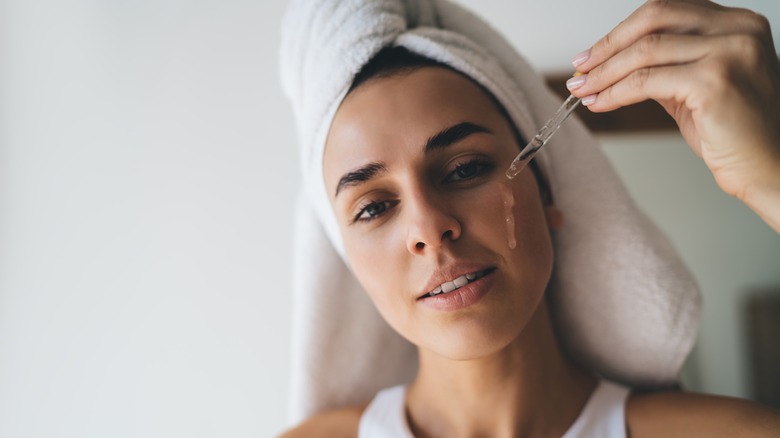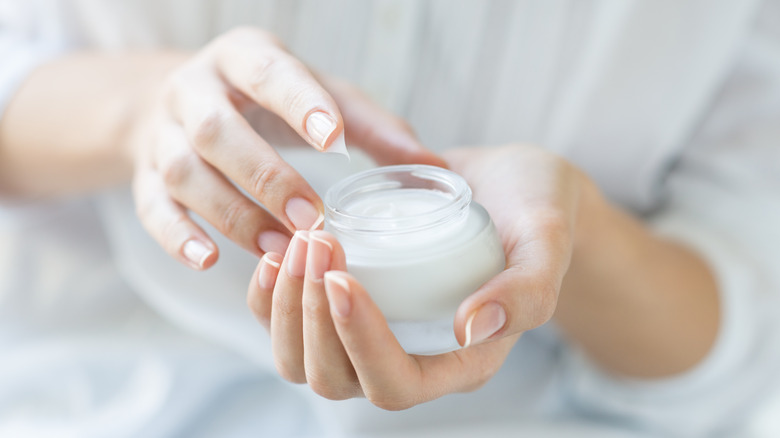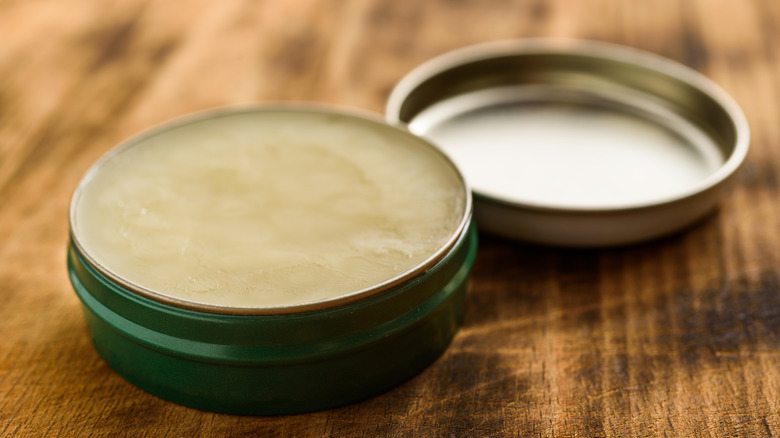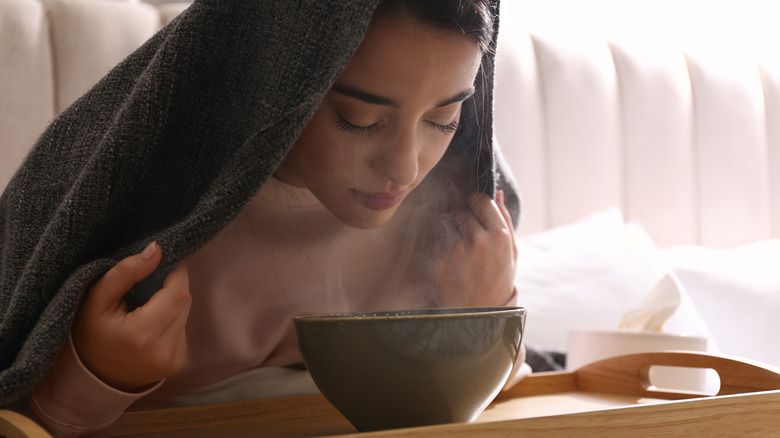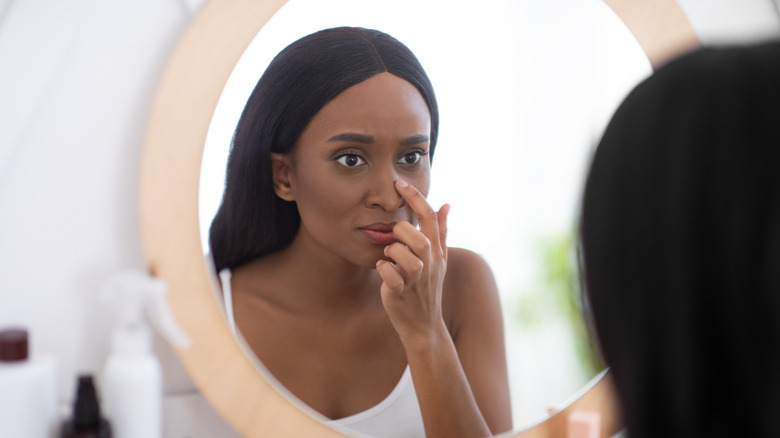Our Best Tips For Hydrating Dry Skin Around Your Nose
Before we jump into tips for hydrating dry skin around your nose, let's find out what might be causing this skin issue in the first place. Research published in the journal Frontiers states that the nasolabial folds (the creases of skin that extend from the sides of your nostrils to the corners of your mouth) are the most sensitive areas of the face. This means extra care is needed to maintain healthy feeling skin in this area.
Seasonal changes are a common cause of a shift in hydration levels in the skin. According to a study published in the Journal of the European Academy of Dermatology and Venereology, a combination of low humidity and low temperatures decreases the skin's barrier function and increases the skin's susceptibility to stress. The skin barrier is the uppermost layer of skin, and its job is to protect deeper skin layers from damage due to outside factors, like harsh weather, pollutants, and irritants. Other reasons you may see dryness around your nose are the use of the wrong skincare products for your skin type, using overly hot water to wash your face, and not getting enough healthy fats in your diet.
Dry skin around the nose often leads to the appearance of redness, irritation, flaking, and itching, which can be uncomfortable and make applying makeup practically impossible. The good news is that we have simple tips for making your skin feel supple, smooth, and hydrated.
Identify your skin type
Is your skincare routine on autopilot? It's super important to make sure you are using the right skincare products for your skin type. Using the wrong products can result in skin issues like dryness, excess oiliness, or acne. For a simple breakdown, follow our tips and tricks for determining your skin type.
If you consistently experience dryness around your nose but nowhere else, chances are you have combination skin. We typically think of this skin type as having an oily T-zone. But dry patches can crop up anywhere alongside otherwise normal or oily skin zones. Those who fall into the combination skin type category benefit from using different types of products on the different areas of their face. For example, if your cheeks and neck tend to be normal, pimple-free, and easy to care for, but the areas around your nose, the sides of your mouth, and between your eyebrows get dry and flaky, using a more emollient moisturizer (and some gentle exfoliation) will help to keep your complexion balanced. Bottom line, don't be afraid to mix up which products you use where.
Once you know your skin type, choose products designed specifically for your skin. While your true skin type stays the same, your skin's needs may change slightly due to a variety of factors. A shift in seasons, different stages of life, and travel are some of the things that affect how your skin behaves. Don't be afraid to switch up your skincare products accordingly.
Use a mild cleanser
A survey conducted by skincare brand CeraVe showed that 80% of Americans are washing their skin incorrectly, unfortunately using the wrong products and overly harsh ingredients to cleanse their skin.
The nose area is a common zone for pimples and blackheads, which makes it a tempting spot for over-cleansing and over-exfoliating. Did you know that too much of these good things can actually cause the skin to become dry and flaky? Over-cleansing disrupts the skin's natural microbiome, according to research published in Practical Dermatology, which can create such skin conditions as dryness, irritation, inflammation, and itching.
When cleansing this area (and, really, any area of your face), opt for the gentlest cleanser made for your specific skin type. Use cleansers made with harsher ingredients, like benzoyl peroxide, less often and only if necessary. As for exfoliation, if you are experiencing dryness, a once-weekly sloughing is probably sufficient. Opt for an exfoliant made with fruit acids instead of exfoliating granules for a gentler touch, and never exfoliate broken or irritated skin.
Don't skip the serum
Have you yet to add a serum to your skincare routine? This product type is available in formulas designed for every skin type, and serums are super concentrated to deliver the maximum amount of benefits to the skin.
Think of moisturizing ingredients in two parts: humectants and emollients. Humectant ingredients attract water from skincare products and the environment to hydrate the skin. Examples of these are hyaluronic acid and glycerin. Emollient ingredients provide moisture and are most like the skin's own natural sebum. Think natural plant oils, like jojoba and almond oils.
Serums formulated for dry skin are typically comprised of humectant ingredients because they are applied after cleansing but before applying moisturizer. Choose a serum made with hydrating ingredients and apply it to freshly cleansed skin, then allow the serum to soak in for a short amount of time before applying your moisturizer. Serums are usually lighter weight and it's always best to apply skincare from lightest to heaviest consistency for maximum benefits. Plus, you want to make sure those concentrated serum ingredients are able to penetrate the skin. Finally, as with all of your skincare products, be sure to focus on the areas around your nose, under your nostrils, and on top of your nose, as these areas are easy to miss.
Choose the best moisturizer
Moisturizer is perhaps the most important product in your dry skin arsenal. Take special care when choosing the perfect moisturizer for your skin. And guess what? You might need two: one for morning and another for night. Whatever it takes to get the job done and banish that dry skin around your nose for good.
Okay, when purchasing a moisturizer for dry skin, be sure to opt for a product that is super emollient. What does this mean? Look at the product label for ingredients like natural plant oils, squalane (an emollient ingredient good for ramping up the hydration in the skin and improving skin texture, according to the Cleveland Clinic), and ceramides (fatty acids). Apply your moisturizer over your serum of choice. A study published in the Journal of the European Academy of Dermatology and Venereology states that the consistency and regularity of moisturizer usage are even more important than the moisturizer formula you use. So, don't be shy. Apply moisturizer generously and often to dry skin, focusing on your most parched areas. And, yes, you can reapply moisturizer throughout the day as needed. Carry a smaller size in your bag or purchase a stick moisturizer for convenient skin hydrating on the go.
The beauty of a facial oil
It's difficult to beat facial oil for a feeling of luxury in a skincare product. But facial oils are more than just pretty. Think of them as highly concentrated oil combinations with specific benefits for your skin exclusive to the oils used in the formula. This means that when choosing a facial oil for dry skin, be sure to select one made with highly moisturizing ingredients.
What are the most moisturizing oils? Research published in the International Journal of Molecular Sciences showed that coconut, argan, jojoba, and oat oils were found to offer feelings of skin barrier repair when applied topically. When in doubt as to what oils your skin will like, try jojoba. Jojoba oil is the natural oil most closely matched to the natural oils your skin produces, making it a suitable choice for all skin types. To use facial oil, pat the oil onto your skin and press it in with your fingertips after applying your moisturizer. Use twice daily, or more if you like, for the best results.
As with all of your moisturizers, feel free to layer on more facial oil throughout the day as needed. Can you apply facial oil and other products over makeup? Absolutely! Simply pat a small amount of product on the skin around your nose, allow it a few seconds to absorb, and pat makeup on top.
You might need a balm
We mentioned the two types of moisturizing ingredients, humectants, and emollients. Full disclosure: there is a third type known as occlusive ingredients. Occlusives are thick waxes, butters, and silicones. Think beeswax, petrolatum, dimethicone, and mineral oil. These ingredients work in a different way than other moisturizers by forming a barrier on top of the skin to prevent moisture loss, as explained in information published in Clinical Medicine & Research. The thing is, there must be moisture already on the skin in order for these ingredients to work; otherwise, they can result in even drier feeling skin. Think of occlusives this way — they trap in the moisture from your humectant and emollient ingredients and help to prevent feelings of dryness from outside factors. This is why they must be applied as a last step rather than on their own as a moisturizer.
Skin balms are created from occlusive ingredients and tend to be thicker and more oily feeling than other moisturizing products. To use them most effectively, apply them over your last moisturizing product as a protectant. The best time of day to use a skin balm is at night before bed to avoid overuse and a shiny look. Balms can also come to the rescue for tricky makeup applications. Dry, flaky skin can be a nightmare when it comes to applying concealer or foundation. Pat a thin layer of skin balm on top of dry skin and press the product into the skin before applying makeup for a smoother application.
Daily sunscreen is a must
We are all aware that sunscreen is a year-round necessity when it comes to keeping up the appearance of healthy skin. Facial sunscreens and tinted serums and foundations with SPF all make daily sunscreen application simple to perform and easy to wear.
But how does wearing sunscreen help with your dry skin? Especially dry skin around your nose? A study published in the International Journal of Cosmetic Science analyzed data from the stratum corneum (the outermost layer of the epidermis) after UV exposure and found that commercially available sunscreens were able to maintain and prevent damage to the skin barrier. And we know a compromised skin barrier leads to dryness. Since the area around your nose is the most sensitive area of skin on your face, be sure to protect this area daily. The best way to ensure UV protection every day, rain or shine, is to apply your favorite SPF as part of your morning skincare routine, right after your facial oil. Tinted sunscreen is an easy way to provide coverage with protection. Choose a product with an oil base for a smoother application over dry skin.
Get steamy
If the skin around your nose is stubbornly dry, feels tight, or you are dealing with flakiness in this area, it might be time to break out the big guns. And we are talking about an increase in humidity. You can do this by using a humidifier in your home and office. Try sitting one near your desk or near your bed while you sleep so your skin can soak up some extra moisture.
How does humidity help with dry skin? A study published in Sage Journals found that the stratum corneum hydration of study participants correlated with the humidity levels in their environment. The study stated that a humidifier is an effective and economical solution to dry indoor weather.
Another way to introduce instant humidity to your skin is by steaming your face. To perform a facial steam, pour hot water into a large bowl and lean over the bowl, placing a towel over your head to trap the steam. Be sure not to get close enough to the steam to burn your skin. Allow your face to steam for one to three minutes and then immediately follow up with your moisturizing products to keep moisture from escaping the skin.
But not too hot
A hot, steamy shower feels so good, right? But using super hot water in your shower could be one more reason you are seeing dry skin around your nose. The University of Pittsburgh Medical Center states that showering or bathing in hot water can cause skin inflammation, redness, tightness, itching, and even peeling. Overly hot water can also strip the skin of natural oils and essential proteins necessary for keeping skin healthy, leading to moisture loss and dry skin.
To curb skin dryness due to hot showers, turn down your water temp and opt for warm showers instead, and try to keep your shower time to no longer than 10 minutes. Another tip is to only bathe when necessary and skip using water on your face unless your skin is dirty or you need to remove your makeup. Finally, always moisturize promptly after hopping out of the shower to prevent dryness and feelings of stressed skin.
Protect your nose area when out in the wind and cold
We have already covered the importance of protecting your face with a daily application of sunscreen. But sometimes more protection is required to keep your skin from drying out. If you are living in or traveling to a climate that has cold temps, low humidity, or chilly winds, it's a good idea to cover your face with a scarf or mask. You've seen how the low temps and low humidity combination can compromise your skin barrier and lead to skin dryness. Well, windburn is another factor when it comes to dry skin.
The Skin Cancer Foundation reports that the outermost layer of the skin becomes dried out and weakened when exposed to the wind. This damage to the stratum corneum can also make skin more susceptible to UV damage. If you will be spending time outside in the wind — say, hitting the slopes — be sure to cover your face for an added layer of protection against dryness and skin damage.
Eat right for your skin
You know the saying: You are what you eat. Eating for healthy skin may not be as instant a fix as applying moisturizer or steaming your face, but the long-term benefits make a big time difference in your complexion. Research published by Dermatology Practical & Conceptual states that certain foods can help to support proper skin barrier function and defend against skin dryness.
Omega-3 fatty acids were shown to increase hydration in the skin and support the skin barrier function. Foods like these include salmon, flaxseed, chia seeds, and walnuts. Hempseed oil was also shown to improve skin dryness. Try adding a teaspoon or two to your smoothies, soups, and salads. Of course, drinking plenty of water also helps to keep your skin looking and feeling its best. The Mayo Clinic recommends adult women drink 11.5 cups, or 2.7 liters, of water each day, while men should shoot for 15.5 cups, or 3.7 liters of water daily.
When to see your doctor
If dryness persists after trying our tips, or if your skin becomes red, irritated, or broken out, it might be time to contact your doctor or dermatologist. Cracked skin can allow bacteria to enter, inviting infection. Eczema can also appear as dry skin, so you might need a different course of action to treat your skin issue. Your physician will assess your skin condition and provide a diagnosis to get to the root of the problem so that they can prescribe a treatment plan.
If your skin feels painful, the dryness is not improving, or your condition is getting worse in other ways, it is best to get professional advice. There are many tactics you can add to your regular skincare routine to avoid excess dryness and keep your skin feeling healthy. Our tips for hydrating dry skin around your nose are a great place to start, but if you feel your skin needs further attention, don't wait to reach out to your doctor for more information.
